Gym mats are essential for fitness, offering cushioning and preventing injuries during exercises. They provide grip, hygiene, and protection for both users and subfloors, ensuring safe workouts.
1.1 History and Evolution of Gym Mats
The history of gym mats dates back to ancient civilizations, where people used animal hides and woven reeds for cushioning during physical activities. In the Middle Ages, gymnastics became more structured, with mats made from canvas or cloth for basic protection. The 20th century saw the introduction of synthetic materials like PVC and rubber, revolutionizing durability and hygiene. Modern gym mats now feature advanced materials such as cross-linked polyethylene foam, offering superior shock absorption and versatility. Over time, designs have evolved to cater to specific needs, including interlocking and folding options, while prioritizing safety and comfort for various exercises and sports.
1;2 Importance of Gym Mats in Fitness
Gym mats play a crucial role in ensuring safety and comfort during fitness activities. They provide a cushioned surface that absorbs shocks, reducing the risk of injuries from falls or impacts. Mats also offer grip, preventing slippage during exercises, especially in dynamic movements. Additionally, they protect subfloors from damage caused by dropped weights or equipment. Hygiene is another key benefit, as many mats are made with antimicrobial materials. Their versatility allows them to be used for various exercises, from yoga to high-intensity training. Overall, gym mats are indispensable for creating a safe, clean, and effective workout environment, making them a fundamental tool in both professional and home fitness settings.
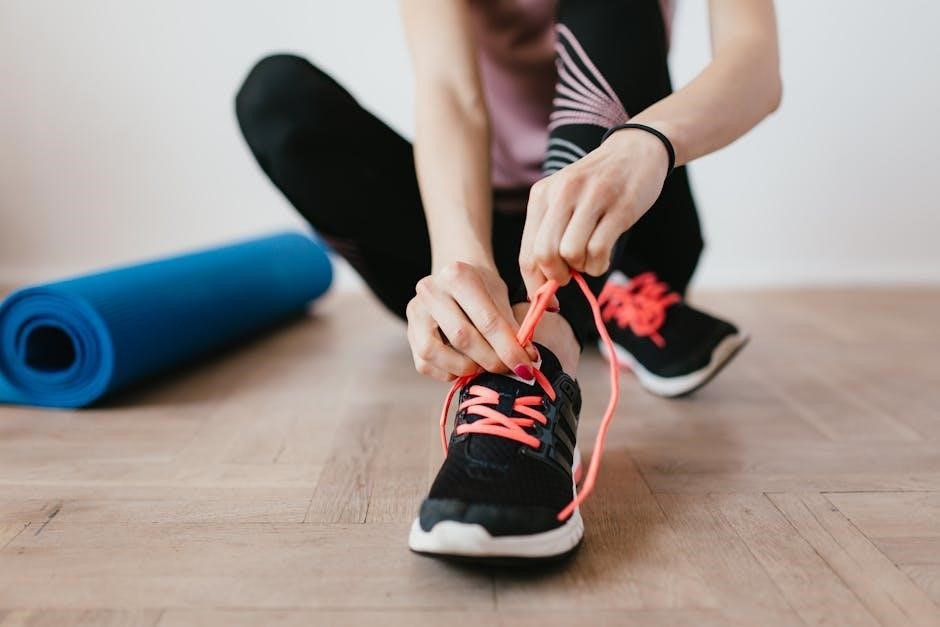
Types of Gym Mats
Gym mats come in various forms, including folding, rolled, interlocking, and specialty options, each designed for specific exercises, durability, and ease of use in different fitness settings.
2.1 Folding Gym Mats
Folding gym mats are a popular choice for their portability and convenience. Designed with durable materials like vinyl or Crosslink polyethylene foam, they offer excellent cushioning and support. These mats are ideal for temporary setups, as they can be easily folded and stored after use. They are widely used in schools, gyms, and home workouts, providing a comfortable surface for exercises, stretching, and gymnastics. Their non-tear surfaces ensure longevity, while their lightweight design makes them easy to transport. Additionally, folding mats are often used in martial arts and other activities requiring a padded, safe environment. This makes them a versatile option for various fitness needs.
2.2 Rolled Gym Mats
Rolling gym mats are a popular choice for their ease of storage and setup. Typically made from high-density foam or rubber, they provide excellent cushioning and support for various exercises. These mats are often used in professional and school settings due to their durability and versatility. They are ideal for gymnastics, martial arts, and high-impact activities, offering superior shock absorption. Rolled mats are also convenient for temporary setups, as they can be easily unrolled and secured. However, their bulkiness can make them less portable than folding mats. Despite this, they remain a preferred option for their ability to provide a large, continuous workout surface and long-lasting performance.
2.3 Interlocking Gym Mats
Interlocking gym mats are a versatile and practical choice for creating customizable workout surfaces. Designed with a modular system, these mats feature edges that connect seamlessly, allowing users to expand or reshape their workout area as needed. They are commonly used in home gyms, martial arts studios, and commercial fitness centers. The interlocking design ensures a secure fit, reducing the risk of mats shifting during exercise. Made from durable materials like PVC or rubber, these mats offer excellent cushioning, shock absorption, and traction. They are easy to install and can be arranged to fit various spaces, making them ideal for both temporary and permanent setups. Interlocking mats are also easy to clean and maintain, providing a hygienic and comfortable surface for a wide range of activities.
2.4 Specialty Gym Mats
Specialty gym mats are tailored for specific activities or advanced training needs. These mats often feature unique designs, such as anti-microbial coatings or embedded technology to measure performance metrics. For instance, some high-end models incorporate pressure-sensing layers to track workouts. Made from premium materials like dense foam or rubber, they provide superior cushioning and durability. Specialty mats are ideal for professional athletes, martial arts practitioners, or those requiring extra support. They are also used in niche settings, such as yoga studios or rehabilitation centers, where specific surface textures or thicknesses are needed. These mats are designed to meet the demands of specialized training, ensuring optimal performance and safety for users engaging in high-impact or precision-based exercises.
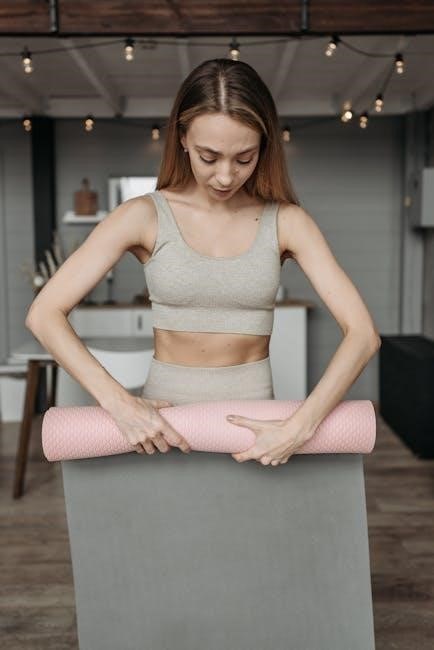
Materials Used in Gym Mats
Gym mats are made from durable materials like PVC, PE foam, and rubber. These materials provide cushioning, support, and protection during exercises, ensuring safety and comfort for users.
3.1 PVC Gym Mats
PVC gym mats are popular for their durability and versatility. Made from high-quality polyvinyl chloride, these mats are lightweight, easy to clean, and resistant to moisture. They are often used in gymnastics, general exercises, and PE activities due to their anti-microbial properties, which prevent the growth of bacteria and odors. PVC mats are constructed with a layered PE foam core and canvas, providing excellent support and cushioning. Their smooth, textured surfaces ensure a firm grip, reducing the risk of slipping during workouts. Ideal for both home and professional gym settings, PVC mats are a cost-effective solution for fitness enthusiasts seeking a reliable and hygienic training surface.
3.2 PE Foam Gym Mats
PE foam gym mats are renowned for their exceptional cushioning and shock absorption, making them ideal for high-impact activities like gymnastics and martial arts. Constructed from high-density polyethylene foam, these mats provide a soft, yet durable surface that protects joints during landings and exercises. The closed-cell structure of PE foam ensures resistance to moisture and bacteria, making them easy to maintain. Available in various thicknesses, PE foam mats are suitable for both professional and home use. Their lightweight design allows for easy transportation and storage. Additionally, the foam’s resilience ensures long-lasting performance, offering consistent support and comfort for users across different fitness disciplines.
3.3 Rubber Gym Mats
Rubber gym mats are highly durable and versatile, often made from recycled rubber materials. They provide excellent shock absorption, making them ideal for weightlifting and high-impact activities; Available in various thicknesses, these mats are suitable for both home and professional gym settings. Their textured surfaces enhance traction, reducing the risk of slips. Rubber mats are also resistant to heavy wear and tear, ensuring long-lasting performance. They can be easily installed over concrete, wood, or tile floors. Additionally, rubber gym mats are eco-friendly, as many are made from repurposed rubber materials. Their dense structure offers superior protection for subfloors and equipment, making them a practical choice for intensive workouts and heavy-duty use. Proper maintenance ensures they remain effective and hygienic over time.
3.4 Hybrid Material Gym Mats
Hybrid material gym mats combine multiple materials, such as PVC, PE foam, and rubber, to offer enhanced performance. These mats are designed for versatility, providing superior shock absorption, durability, and comfort. The layered construction ensures excellent cushioning while maintaining stability during exercises. Hybrid mats are ideal for both home and professional gym use, offering resistance to wear and tear. They are easy to clean and maintain, making them a practical choice for high-traffic areas. Their multi-material design allows for customization in thickness and texture, catering to various fitness needs. Hybrid mats are also eco-friendly, as they often incorporate recycled materials. Their versatility and adaptability make them a popular option for modern fitness enthusiasts seeking high-quality, long-lasting gym mats.
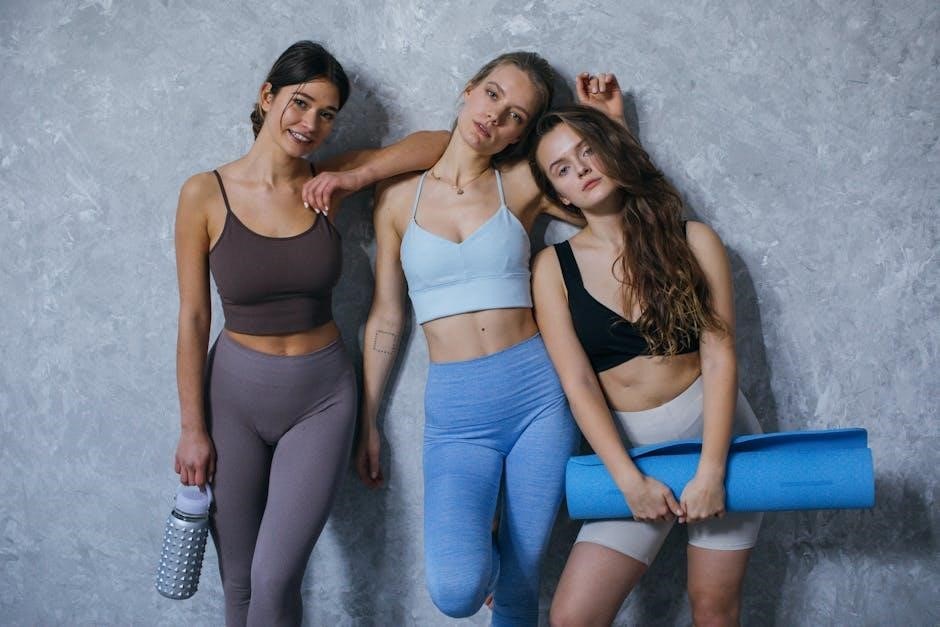
Benefits of Using Gym Mats
Gym mats provide shock absorption, reducing injury risks and enhancing comfort. They offer hygiene benefits with easy cleaning, minimize noise, and protect subfloors from damage during workouts.
4.1 Shock Absorption and Injury Prevention
Gym mats play a crucial role in absorbing shocks during high-impact activities, significantly reducing the risk of injuries. Their dense foam cores, often made of materials like PE foam or rubber, cushion falls and impacts, protecting joints and muscles. Mats with thickness levels of 30 kg/m³ or higher are particularly effective for gymnastics and martial arts, where landings can be harsh. By distributing pressure evenly, they minimize the stress on the body, preventing bruises and sprains. This makes them indispensable for activities involving tumbling, jumps, or weight drops, ensuring safer training sessions. The shock-absorbing properties not only protect the user but also extend the lifespan of the subfloor, making them a vital investment for any fitness space;
4.2 Hygiene and Easy Cleaning
Maintaining hygiene is crucial for gym mats, as they can harbor bacteria and odors. Many mats are made from easy-to-clean materials like PVC or rubber, which are waterproof and resistant to fungi. Regular cleaning with mild detergents and water prevents the buildup of sweat and grime. Anti-microbial treatments in some mats further enhance hygiene. Mats with smooth, non-porous surfaces are easier to sanitize, reducing the risk of infections. Proper cleaning not only prolongs the mat’s lifespan but also ensures a fresh, odor-free environment for workouts. Regular maintenance is essential to keep gym mats hygienic and safe for users, promoting better health and performance in fitness routines.
4.3 Versatility in Different Exercises
Gym mats are incredibly versatile, catering to a wide range of exercises and activities. They provide a comfortable surface for yoga, Pilates, and stretching, while also offering support during high-impact workouts like aerobics or plyometrics. For martial arts and gymnastics, mats ensure safe landings and protection from impact. They are also ideal for weightlifting, as they cushion the floor from dropped weights and reduce noise. Additionally, interlocking mats create large, customizable spaces for group classes or home workouts. Their textured surfaces offer traction, preventing slipping during dynamic movements. Whether for cardio, strength training, or flexibility exercises, gym mats adapt to various fitness needs, making them an essential tool for any workout setting.
4.4 Noise Reduction
Gym mats play a significant role in reducing noise during workouts, especially in home gyms or shared spaces. Their thick, dense materials absorb impact sounds from dropped weights or foot movements, minimizing echoes and vibrations. For instance, high-density rubber mats are particularly effective at dampening noise, making them ideal for weightlifting areas. Additionally, foam and hybrid mats soften landings and muffle sounds during exercises like jumping or burpees. This noise reduction not only enhances the workout experience but also minimizes disturbances in multi-use environments. By cushioning impacts and absorbing sound, gym mats create a quieter, more focused training atmosphere, benefiting both individuals and those around them.
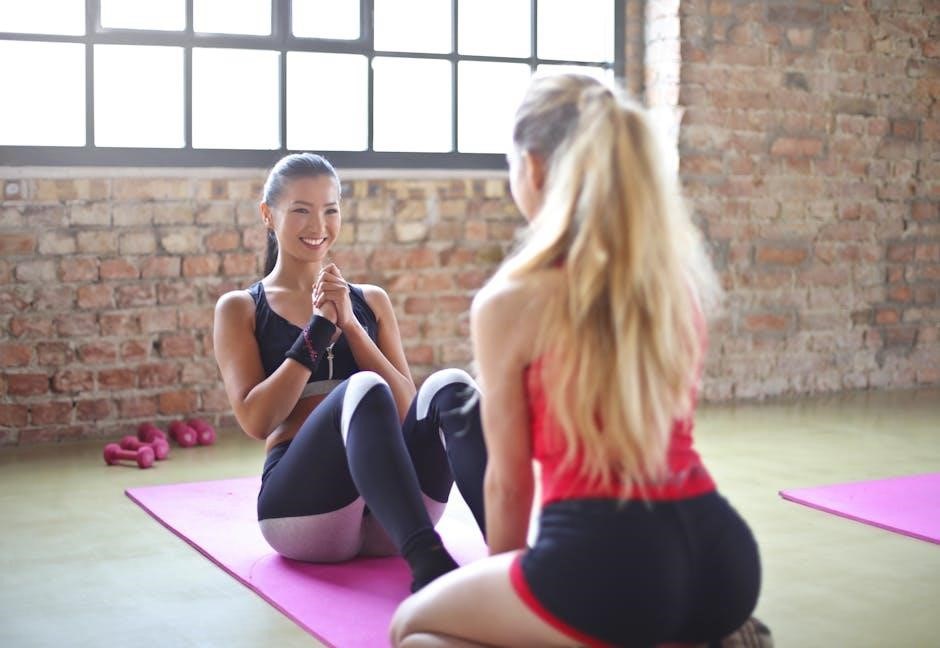
Maintenance and Care
Regular cleaning with water and mild detergents maintains hygiene. Proper storage and handling prevent damage, ensuring longevity and performance of gym mats.
5.1 Cleaning Gym Mats
Regular cleaning of gym mats is crucial for maintaining hygiene and extending their lifespan. Use mild detergents and water to wipe down the surface, avoiding harsh chemicals that may damage the material. For PVC and rubber mats, a soft sponge or cloth is recommended to prevent abrasions. After cleaning, ensure the mats are thoroughly dried to prevent moisture buildup, which can lead to mold or mildew. For folding or rolled mats, clean each panel separately and allow them to air dry before storage. This routine helps maintain a clean and sanitary environment for workouts, reducing the risk of germs and odors. Always avoid using machines or excessive heat, as they may damage the mat’s structure.
5.2 Storage and Handling
Proper storage and handling of gym mats are essential to maintain their quality and longevity. Folding mats should be stored upright or laid flat in a dry, cool place to prevent creasing or bending. Rolled mats can be stood vertically or hung to maintain their shape. For interlocking mats, disassemble them before storage to avoid moisture buildup between pieces. Always clean the mats before storing to prevent mold or mildew. Avoid stacking heavy objects on top of the mats, as this can cause permanent indentations or damage. When transporting, carry mats by the edges or use handles if available to prevent tearing. Store in a well-ventilated area away from direct sunlight to prevent material degradation. Proper handling ensures mats remain in optimal condition for future use.
5.3 Repairing Damaged Mats
Repairing damaged gym mats is crucial to extend their lifespan and ensure safety during use. For minor tears or punctures, apply a sturdy adhesive patch specifically designed for the mat material. For PVC mats, a vinyl repair kit works well, while foam or rubber mats may require a flexible glue. Clean the area around the damage thoroughly before applying any repair material. Allow the adhesive to dry completely as per instructions to ensure a strong bond. For larger damages or deep cuts, professional repair or replacement may be necessary. Regular inspection can help identify issues early, preventing further deterioration. Always follow manufacturer guidelines for repairs to maintain the mat’s integrity and performance.
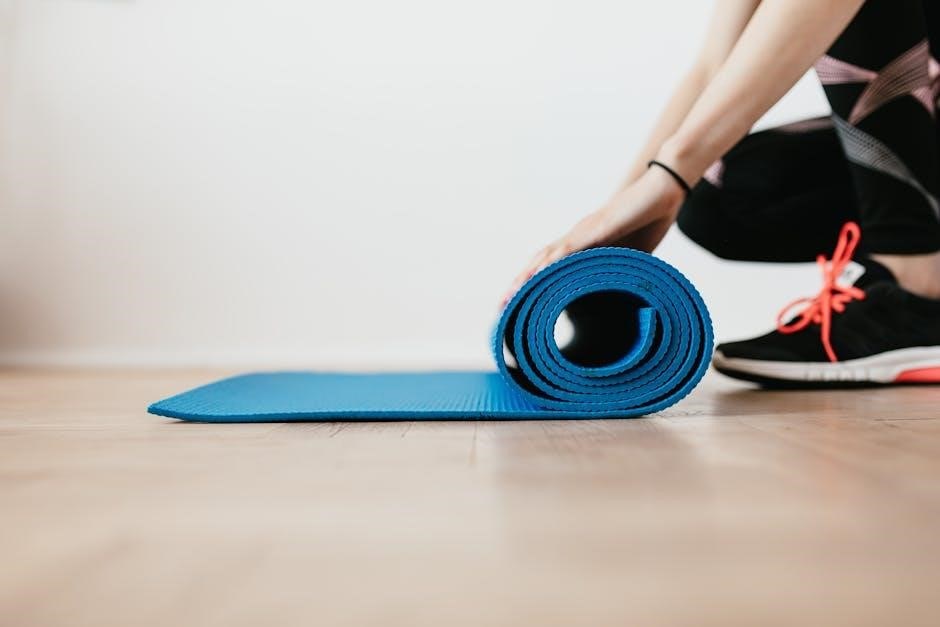
Safety Considerations
Proper storage and cleaning of gym mats are vital to prevent accidents and ensure a safe workout environment, as highlighted by past incidents like the 2013 case;
6.1 Preventing Injuries
Gym mats play a crucial role in preventing injuries by providing cushioning and grip during exercises. High-density foam cores absorb shock, reducing impact on joints and muscles. Proper mat storage and cleaning are essential to avoid accidents, as highlighted by incidents like the 2013 case where a teenager suffocated in a rolled-up mat. Ensuring mats are securely fastened and stored upright can prevent such tragedies. Additionally, slip-resistant surfaces and durable materials help minimize risks during intense workouts. Regular inspections for wear and tear are vital to maintain safety standards. By prioritizing mat quality and usage guidelines, injuries can be significantly reduced, ensuring a safer environment for all fitness activities.
6.2 Slip Resistance
Slip resistance is a critical feature of gym mats, ensuring users maintain stability during workouts. Textured surfaces and high-traction materials, such as PVC and rubber, minimize the risk of slipping. Studded rubber mats, for instance, provide excellent grip, even when wet. Proper cleaning and maintenance are essential to preserve traction, as dirt and sweat can compromise slip resistance. Mats designed for martial arts and gymnastics often feature non-slip backing, preventing movement during intense exercises. This feature is particularly important in high-impact activities, where a loss of footing could lead to accidents. By combining durable materials with innovative textures, modern gym mats effectively enhance safety and performance across various fitness routines.
6.3 Protection for Subfloors
Gym mats play a vital role in protecting subfloors from damage caused by heavy equipment, dropped weights, and high-impact exercises. Thick, durable materials like rubber and PVC act as a barrier, absorbing shocks and preventing scratches or dents. High-density foam cores in gym mats effectively cushion impacts, ensuring floors remain intact even during intense workouts. Additionally, large-format mats cover extensive areas, providing comprehensive protection for various training activities. Their textured surfaces also prevent equipment from slipping, further safeguarding the subfloor. By installing gym mats, facilities can maintain the integrity of their flooring, reducing long-term maintenance costs and ensuring a safe, stable environment for all exercises.
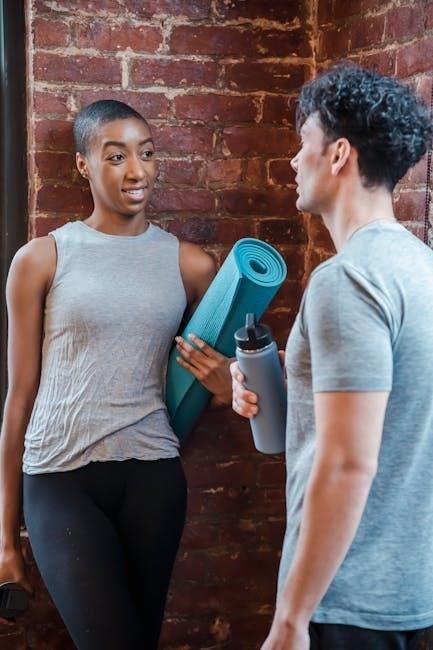
Choosing the Right Gym Mat
Selecting the ideal gym mat involves considering size, thickness, and material. Thickness ranges from 1/4″ to 2″ for various activities, ensuring proper cushioning and support for exercises, from yoga to high-impact training.
7.1 Size and Thickness Considerations
Gym mats come in various sizes and thicknesses to suit different needs. Common thicknesses range from 1/4″ to 2″, with thinner mats ideal for yoga and low-impact exercises, while thicker mats provide superior cushioning for high-impact activities like gymnastics or weightlifting. Size options vary from compact 24″ x 48″ mats for personal use to larger 4′ x 8′ mats for professional or studio settings. The choice depends on the intended use, available space, and preferred level of comfort. Proper sizing ensures safety and efficiency during workouts, while thickness determines the mat’s ability to absorb shocks and protect joints. Selecting the right dimensions and thickness is crucial for optimal performance and injury prevention.
7.2 Material Selection
Choosing the right material for your gym mat is crucial for performance and durability. PVC mats are popular for their anti-microbial properties and durability, making them ideal for high-traffic areas. PE foam mats offer excellent cushioning and are lightweight, suitable for low-impact exercises. Rubber mats, often made from recycled materials, provide superior shock absorption and are eco-friendly. Hybrid mats combine materials like foam and rubber for balanced comfort and support. Consider factors like moisture resistance, grip, and noise reduction when selecting the material. Higher-density materials are best for heavy use, while softer options prioritize comfort. The right material ensures safety, hygiene, and longevity, tailored to your specific fitness needs and preferences.
7.3 Brand and Quality
When selecting a gym mat, prioritizing brand reputation and quality is essential for durability and performance. Reputable brands like Promat and Greatmats offer high-quality products designed for safety and longevity. Look for materials like cross-linked polyethylene foam or high-density rubber, which provide superior cushioning and resistance to wear. Ensure the mat meets safety certifications and is free from harmful chemicals. Higher-quality mats often feature anti-microbial treatments, enhancing hygiene. Investing in a reputable brand ensures better shock absorption, grip, and noise reduction. Always check customer reviews and product specifications to confirm the mat suits your intended use. A high-quality mat not only enhances performance but also protects your subfloor and reduces injury risks, making it a worthwhile investment for any fitness space.
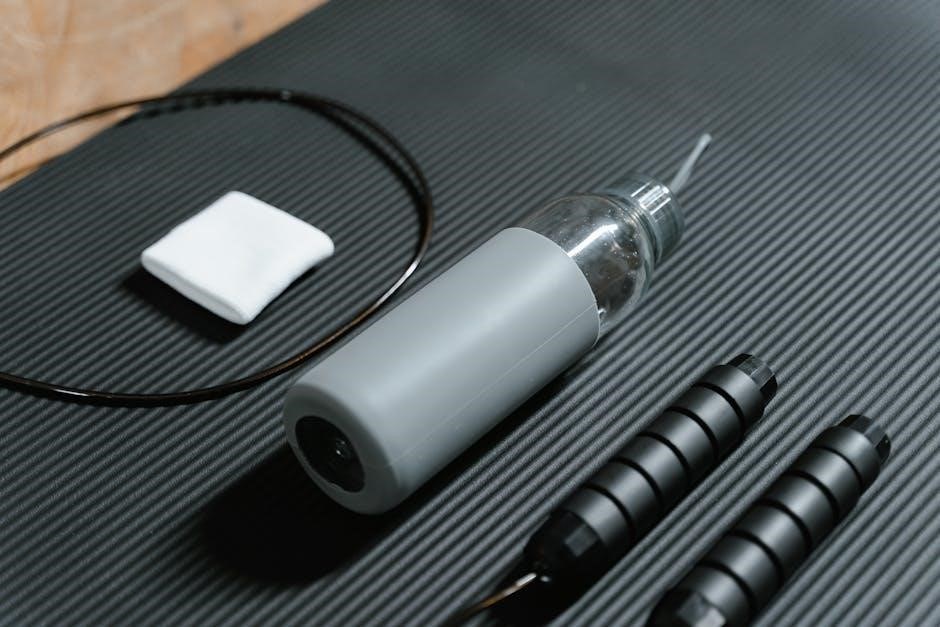
Regulations and Standards
Gym mats must meet safety certifications and fire resistance standards. Materials like PVC and rubber comply with international regulations, ensuring durability and eco-friendly options for various fitness settings.
8.1 Safety Certifications
Safety certifications ensure gym mats meet international standards for durability, performance, and user protection. Materials like PVC, PE foam, and rubber are tested for compliance with fire resistance and emission standards. Many mats are certified for shock absorption, slip resistance, and microbial resistance. For example, anti-microbial PVC mats are designed to prevent germ growth, while high-density foam cores meet safety norms for gymnastics and martial arts. Certifications also verify eco-friendliness, such as low VOC emissions. Look for products that adhere to EN, ASTM, or ISO standards, ensuring they are safe for both home and commercial use. Always check for third-party testing to confirm compliance with safety regulations, protecting both users and facilities from potential risks. Proper certification ensures a mat’s suitability for its intended use, providing peace of mind for athletes and facility owners alike.
8.2 Fire Resistance Standards
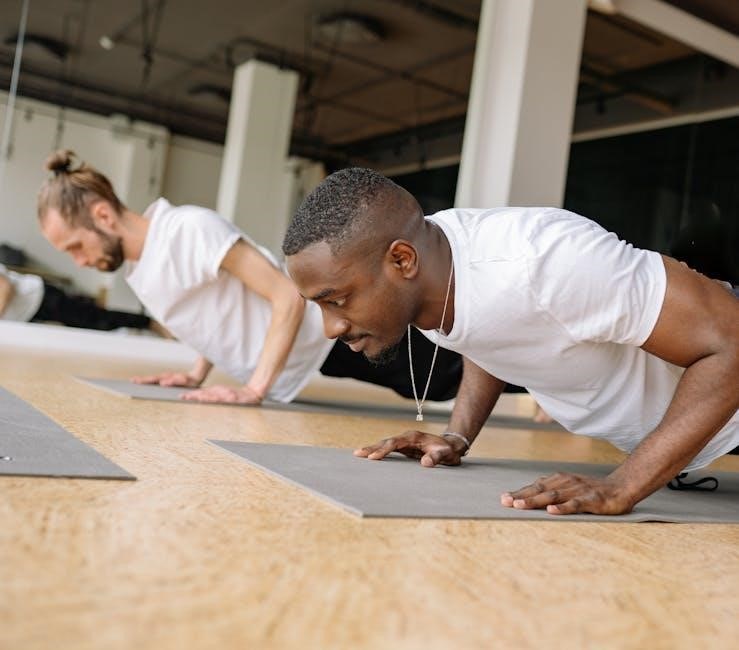
Fire resistance standards for gym mats ensure they meet specific safety criteria in case of emergencies. Materials like rubber and PVC are tested for flammability and smoke emission. These standards guarantee mats won’t ignite easily or release harmful fumes. Compliance with regulations like EN 13501 or ASTM E84 is crucial, especially in public facilities. Some mats are treated with fire-retardant coatings, enhancing safety. Certifications ensure minimal risk during fires, protecting people and property. Always verify fire resistance ratings to ensure compliance with local building codes and safety norms.

Environmental Impact
Eco-friendly gym mats are made from recycled materials like rubber, reducing environmental impact. Proper recycling and disposal methods ensure sustainability and minimize landfill waste.
9.1 Eco-Friendly Options
Eco-friendly gym mats are designed to minimize environmental impact while maintaining durability and performance. Many modern mats are crafted from recycled materials such as recycled rubber or PVC, reducing the demand for raw resources. These mats are often produced with non-toxic additives, making them safer for both users and the environment. Additionally, some manufacturers incorporate biodegradable components to further reduce their ecological footprint. Eco-conscious options also focus on sustainable manufacturing processes, such as energy-efficient production and minimal waste generation. By choosing eco-friendly gym mats, consumers contribute to a greener planet while enjoying high-quality products for their fitness needs.
9.2 Recycling and Disposal
Proper recycling and disposal of gym mats are crucial for reducing environmental impact. Many gym mats are made from materials like PVC, rubber, and foam, which can be recycled or repurposed. Recycling programs often accept these materials, transforming them into new products such as flooring or playground surfaces. Improper disposal, such as sending mats to landfills, can harm the environment due to their slow decomposition. Some manufacturers offer take-back programs to ensure responsible recycling. Users are encouraged to check local regulations and partner with eco-conscious providers to ensure gym mats are disposed of sustainably. This approach minimizes waste and promotes a greener future for fitness equipment.
Gym mats are vital for safety, hygiene, and versatility in fitness. Durable materials like PVC and rubber ensure long-term use, while eco-friendly options support sustainable practices, making them essential for modern workouts.
10.1 Summary and Final Thoughts
Gym mats are indispensable for modern fitness routines, offering safety, comfort, and durability. They cater to various exercises, from yoga to high-impact sports, ensuring optimal performance. High-quality materials like PVC, rubber, and foam provide excellent cushioning and longevity. Proper maintenance, including regular cleaning and storage, extends their lifespan. Safety considerations, such as slip resistance and shock absorption, are crucial to prevent injuries. Eco-friendly options and recyclable materials highlight their environmental benefits. When choosing a gym mat, prioritize size, thickness, and material based on your needs. Ultimately, investing in a reliable gym mat enhances workouts and protects both users and subfloors, making it a vital addition to any fitness space.